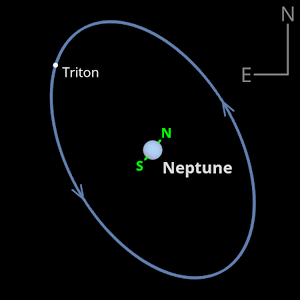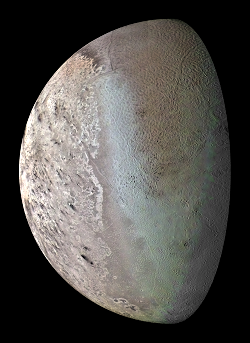2020 August 21
How to find Triton, Neptune’s largest moon
Neptune reaches opposition at 19h UT on 11 September 2020 in the constellation of Aquarius, but the solar system’s outermost planet is closest to Earth 18 hours earlier when it lies 28.92 astronomical units (or 4.33 billion kilometres) from us.
Despite being a gas giant almost four times the diameter of our planet, Neptune is so far away that it requires a 6-inch or larger telescope and a magnification of around 200× to clearly resolve its tiny bluish disc.
The outermost planet attains a maximum angular diameter of just 2.36 arcseconds at best this year and glows at magnitude +7.8, making it a viable (though star-like) binocular target under dark skies. Downloadable finder charts are available at the bottom of the page.

Tracking Triton
Observers with 8-inch aperture and greater telescopes may wish to locate Triton, the largest of Neptune’s 14 known moons discovered by English astronomer William Lassell just 17 days after its parent planet was found on 23 September 1846.
Triton lies at a distance of 354,760 kilometres from Neptune in an almost circular orbit with a period of 5 days 21 hours. Hence it lies closer to Neptune than our Moon’s distance from Earth.
Of a similar composition to Pluto and most likely to be a dwarf planet captured from the Kuiper Belt, Triton has a diameter of 2,700 kilometres making it three-quarters the size of our own Moon. Unusually, Triton is the only large moon to have a retrograde orbit – one that is in the opposite direction to its home planet’s rotation.

Clearly, it makes sense attempting to spot Triton at those times when it is near either an easterly or westerly elongation from Neptune and, preferably, the Moon is absent from the sky.
Westerly elongations of Triton occur on 2, 8, 14, 19 and 25 September and 1, 7, and 13 October. Easterly elongations of Triton occur on 30 August, 5, 11, 17, 22 and 28 September and 4 October.
Note that Triton actually lies to Neptune’s northeast at greatest easterly elongation, and to the planet’s southwest when at greatest westerly elongation.
For further information about observing the outermost planet, be sure to visit the Saturn, Uranus and Neptune Section. Printable PDF finder charts for Neptune during 2020 created by Dominic Ford are available for download in both dark-on-light and light-on-dark formats.
| The British Astronomical Association supports amateur astronomers around the UK and the rest of the world. Find out more about the BAA or join us. |
